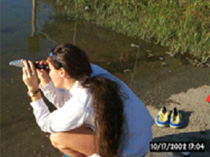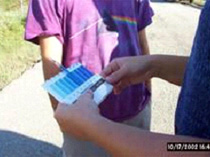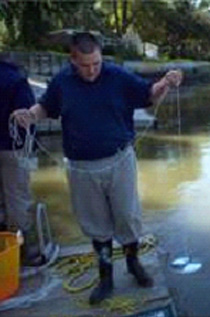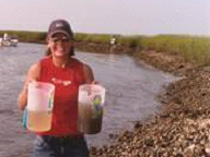Salinity, DO, Temperature
Continuous information on water quality can be obtained by deploying automated instrument packages (e.g., YSI, Hydrolab) near restoration sites. An alternative method is the use of field kits for water quality monitoring that can be used by research personnel or community volunteers. Salinity commonly is measured using a handheld refractometer where a few drops of seawater are placed on the instrument’s glass stage and the salinity read through an eyepiece (see Figure). Inexpensive methods for measuring DO include colorimetric determination (see Figure), dissolved oxygen meter and a fiber optic oxygen sensor.
![]() Download dissolved oxygen protocol
Download dissolved oxygen protocol
![]() Download oyster density methods
Download oyster density methods
TSS⁄Turbidity
The amount of suspended material in the water column may indicate potential siltation problems and⁄or food availability (phytoplankton). Turbidity readings measure the transmission of light through water that is limited by the presence of suspended matter including plankton, sand, silt, and clay. Perhaps the simplest method for determining turbidity is with a secchi disc (see Figure). The alternating black and white quadrants on the disk are lowered into the water until no longer visible and the depth of visible light penetration recorded. Greater secchi disc depths indicate greater water clarity and less suspended material. Turbidity also can be measured in the field using a turbidity tube (see Figure). In the laboratory, total suspended sediments (TSS) can be measured using a variety of gravimetric approaches including filtration and differential weighing. Additional approaches including a turbidimeter that passes a beam of light through the sample and measures the quantity of light scattered by particulate matter can be used to measure suspended sediments. Turbidity measurements can be reported as mg⁄L, Nephelometer Turbidity Units (NTUs) or Jackson Turbidity Units (JTUs).




Examples using a refractometer for salinity determination (top left), colorimetric DO reading (top right), secchi disk for water clarity (bottom left), and TSS sample collection (bottom right) (photos from L. Coen and SCORE).







